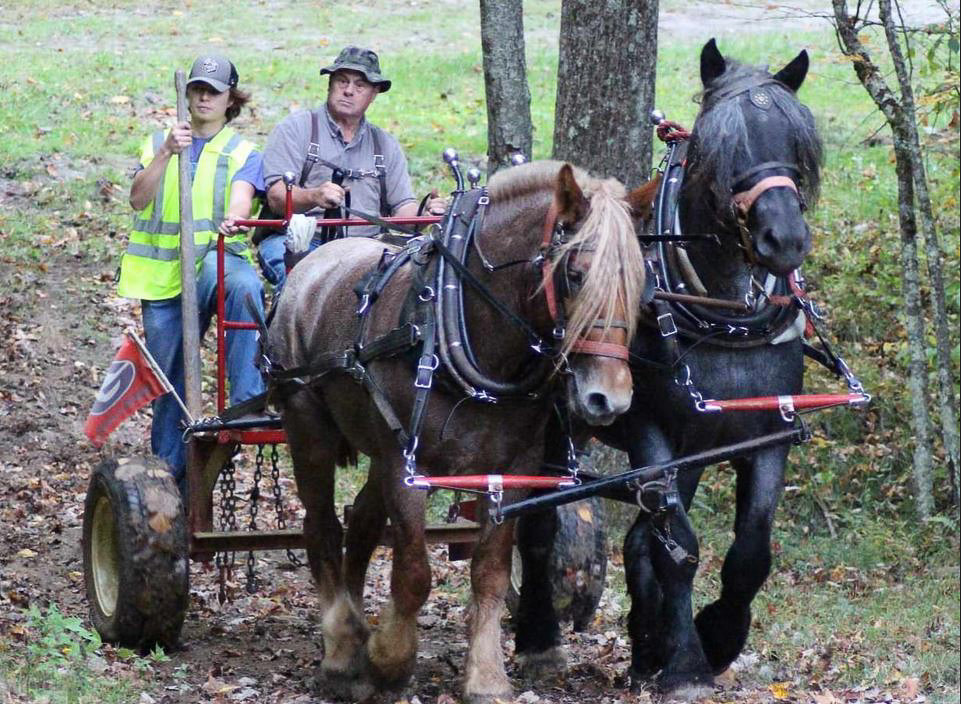
On the Farm: Bridging the Past and Present with Horsepower on the Farm
By Jay Jones
jay.jones@agr.georgia.gov
Todd Harris can plow a field without using a drop of gasoline. On his farm in Jones County, it is just him and his American Brabant stallion, Pete.
“He’s the bedrock of what I’m trying to do,” Harris said.
Harris retired from a career in the Air Force and in civilian life as an electrician and has 26 acres where he grows vegetables. Although his operation is small, three acres and counting as he clears timber, Harris said it has a lot of potential.
He rotates fields with legumes in warm and cool seasons. He grows turnip greens, collards, and squash in the fall, and peas and tomatoes in the summer, which he supplies to friends who operate small food businesses.
“I would like to have sweet corn and okra, but you know, you do what you can,” Harris said. “You try to get better and more productive and larger, so that’s where I’m at.”
American Brabants play a significant role in Harris’s plans. He is not practicing heritage farming, although that was part of what initially drew him to the horses. Harris’s goal is to use horses, and specifically American Brabants, as part of a modern operation.
“I’ve had people say to me, ‘Why don’t you quit living in the past and get you a tractor?’” Harris said. “Well, I’ve had tractors, and there’s nothing wrong with them, in my view on them. And it’s not necessarily about preserving history, but rather about integrating what I consider to be a green energy source: horses. That’s a power source, and there are some innovations out there that allow you to use horses in modern agriculture. I would call it trying to have a diversified homestead.”
Harris eventually does not want to buy fertilizer. Workhorses like Pete can feed themselves, and Harris can adjust their diet with grains for heavier work, such as pulling timber.
Then there’s the experience of working a field with a horse, which Harris said can be therapeutic. “There’s that, and then there’s a part of it that gives me a sense of satisfaction, or whatever you call it, that we’re trying to evolve what is small-scale agriculture, to take some of that stuff that we’ve kind of lost from our forefathers and try to integrate it in a in a system that’s monitored and can be productive,” he said. “That’s really kind of our goal, and a big part of that is the American Brabant horse.”
American Brabants are relatively new to the horse breeding scene. The breed’s forefathers, workhorses from the Brabant region of Belgium, were widely used in the United States from the 1880s through the mid-20th century. The horses were stout and broad, with an easy-going temperament that farmers found to be reliable animals.
Jason Julian, president of the American Brabant Association (ABA), explained that until about 1940, the European Belgian and the American Belgian were essentially the same horse.
Before the 1950s, you were more likely to find work horses or mules pulling a plow in the field or a team of them doing the heavy work, from pulling timber to hauling goods. Julian explained that once the tractors arrived, the Belgian breed in the United States lost its way through crossbreeding. “After the wars, the Belgian horse was no longer needed to power the world, so then people could breed to their heart’s content for the show ring because it didn’t have to perform a function anymore.”
The American Belgian soon changed in appearance and temperament. In the 1960s, U.S. Belgian breeder Albert Stankiewicz sought to bring back the breed as a working horse. He imported the pre-war Belgian Brabant stallions and crossed them with his existing American Belgian mares. Crossbreeding by Stankiewicz and others led to the creation of the American Brabant, a breed distinct from the modern American Belgians and their European counterparts.
Julian is a proponent of integrating horses in modern farming. Operating on 225 acres in northern Wisconsin, Julian runs an organic dairy farm with 50 cows. He grows corn and cuts timber with 13 American Brabants.
He sees the advantages his horses have over machines. “It’s the energy independence, it’s the fact that we’re not running to the parts store, the implement dealer, we’re not getting ourselves in financial debt,” Julian said. “Horses are also very scalable. You can have one horse, two horses or three horses. You can go back to two horses. You can do a single horse job or put all three together for plowing.”
Julian said the only limitation is the humans involved. He advised that people interested in American Brabants should seek out a qualified mentor to see how to work the horses and if it’s right for them. The ABA website, https://americanbrabant.org/, is a great starting point.
Back in Georgia, Harris said he had always had an interest in horses, which started with his grandfather, who farmed about 230 acres of land his entire life with horses. “He never owned a tractor, but when I came along all that was left of the horse farming was some old, rotten equipment, a couple of aged mares and some memories,” he said,” but I always had that in the back of my mind and that’s what motivated me.”
Harris wants to breed American Brabants to produce foals that he can use in teams and sell to like-minded people looking to integrate horses on their farms. Harris said he hopes to raise some horses like Pete. “He’s the best horse I’ve ever had,” he said.
“Pete is hardly any trouble at all. I raised him and trained him from day one, and he is what would be called in our association a good example of a good quality horse,” Harris added. “He’s not the best, he’s not the worst. He is of a good quality.”


